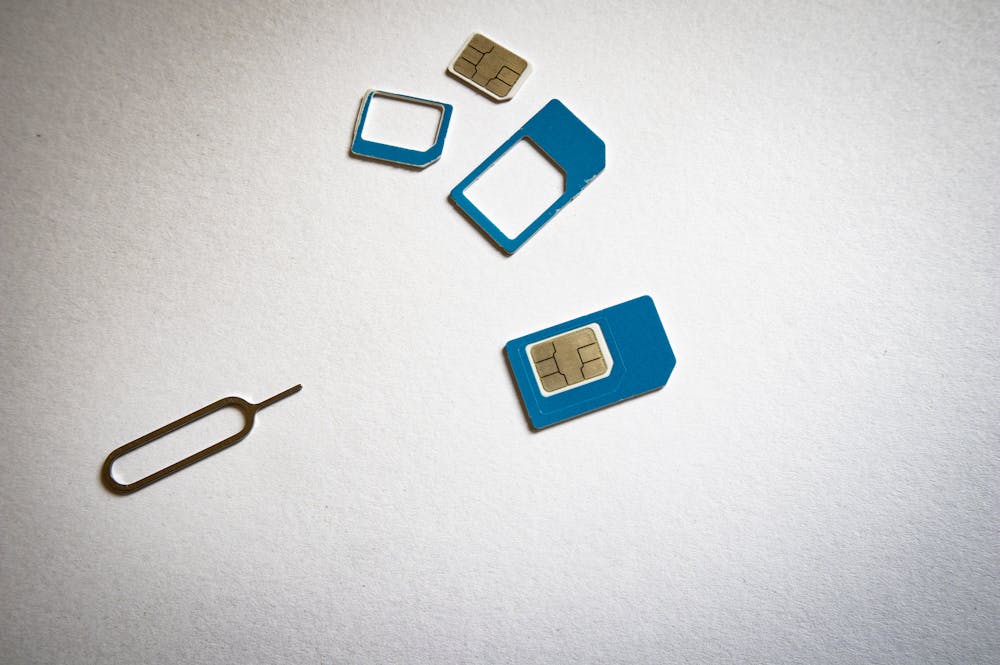
Physical SIM has been one of the main ways people have used to connect to cellular networks for many years. However, with the evolution of technology, the way we connect is also changing. And that is through the innovation of the eSIM.
The eSIM enables individuals to connect to cellular networks in the same way a physical SIM does. However, it promises a better user experience than the physical SIM. Read on to learn more about the difference between the two.
History of SIM technology
The history of SIM technology began in 1991 when the first SIM card was developed by the German smart-card maker Giesecke+Devrient. It was about the size of a credit card and was used to store user identity, authentication keys, and phonebook contacts.
After the first SIM card, other inventions were as follows:
- In 1996, the large credit card-sized SIM was replaced by the much smaller mini-SIM. Its size is about 15 mm * 25 mm
- Around 2010, the SIM card evolved to a micro-SIM. Its size is about 15 mm * 12 mm
- In 2012, there was an invention of an even smaller SIM card, that is, the nano-SIM. It is about the size of a pinkie nail (12.3 mm * 8.8 mm).
- From 2016 to the present, the SIM technology has extended further beyond the physical SIM to embedded SIM. This eSIM does not require individuals to manually remove and insert it into mobile devices like the physical SIM. Instead, it is built into the motherboard of devices.
How eSIMs are embedded and activated
As mentioned above, the eSIM is the latest invention in SIM technology. It is a tiny SIM embedded into smart devices, such as smartphones or smartwatches, during manufacturing. This embedding makes it impossible to remove physically, as you would the physical SIM.
What’s more, it’s not pre-loaded with carrier data until activation takes place. So, how can you activate an eSIM? Well, you can do that by using your wi-fi to install a carrier profile, which can be done through either of the following:
- Scanning a QR code provided by your carrier.
- Using the carrier app to activate directly without scanning QR codes
- Entering the activation code provided by a carrier manually in your device’s settings.
Once you complete any of the above processes, your eSIM will be activated. And you can use it to set up and switch profiles from different countries or regions. For instance, you can set up profiles, such as eSIM Bali, eSIM Egypt, eSIM Japan, or eSIM South Africa. If you are in Bali and want to go to Egypt, you can switch to eSIM Egypt from eSIM Bali.
And if you no longer need the eSIM Bali profile, you can simply remove it from your device by deactivating it. Therefore, it is very easy to activate and switch eSIM profiles. That’s because all processes are online and don’t require any physical removal of SIM cards.
Key differences in use cases
The decision of whether to use a physical SIM or eSIM depends on how you want to use the SIM technology. Below are key differences in different cases:
Frequent traveller
If you are a frequent traveller, the best technology that you can consider is the eSIM. It allows you to download a local carrier profile remotely before arriving in a new country. This profile will activate automatically when you land in the new country.
And it ensures immediate access to the internet. On the other hand, a physical SIM will require you to purchase a local SIM at each destination. Then, physically swap it.
Business users
Most business users require more than one number, which is for personal and business use. An eSIM supports multiple profiles on one device, which can be 8 or more. This allows you to keep personal and business numbers separate without carrying several phones. And you can switch lines digitally in your phone’s settings.
On the other hand, physical SIM cards require phones to have dual SIM slots for business users to have more than one number in line.
Security-conscious users
eSIM provides added protection, which can give security-conscious users peace of mind. It can’t be removed physically. So, it’s theft resistant. And if your device is stolen, carriers can disable the eSIM remotely. Also, an eSIM has fewer cloning risks than a Physical SIM card.
When it comes to the physical SIM, it is vulnerable to physical damage, loss, or theft.
Pros and cons for travellers
Your choice between eSIM or physical SIM can make or break your connectivity experience while traveling. Below are the pros and cons of each for travellers.
eSIM pros for travellers
- Its activation is instant and does not require travellers to hunt for physical SIMs at the airport.
- It allows users to keep their home number active while using a local eSIM for data.
- It requires no physical SIM card. So, there is less risk of losing, damaging, or misplacing tiny SIM cards.
- It ensures eco-friendly traveling, as it requires no plastic physical SIM cards.
eSIM cons for travellers
- It requires an eSIM-compatible phone for use to be possible.
- Some countries or mobile carriers do not support eSIM yet.
- It requires the internet for setup.
Physical SIM pros for travellers
- It works on all phones.
- It requires no internet to set up.
- It is easy to swap SIM cards on different devices.
- It provides local phone numbers for SMS, Calls, or data.
Physical SIM cons for travellers
- It is inconvenient to acquire, as you may need to queue in long lines at the airport. Also, you’ll need to provide ID and paperwork.
- The SIM cards are tiny and easy to lose or misplace while traveling.
- It is limited to one mobile number.
- It comes with cloning risks.
What the shift means for mobile tech
The shift from Physical SIM to eSIM marks a significant change in mobile technology. For one, the embedding of the eSIM paves the way for slimmer and slick phone designs. Also, it ensures that manufacturers have extra space for bigger batteries and new features.
In addition to that, eSIM encourages better security and global connectivity at affordable costs. At the same time, it lays the foundation for future innovations, such as the integrated SIMs (iSIMs). This will further transform connectivity in the mobile and IoT ecosystem.






